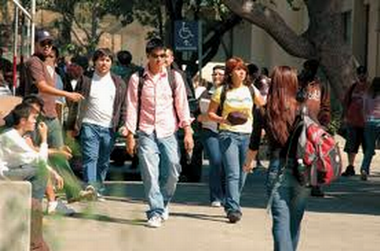
|
|

|
|
| April 26, 2024 |
|
College students inflate poverty rate 
California has one of the nation's higher official poverty rates but a new Census Bureau report indicates that it is fractionally inflated by college students who have low personal incomes.
The Census Bureau made the calculations, it says, because of "numerous telephone inquiries" about whether the presence of large numbers of students had a major impact on poverty rates, which are used for a variety of federal government programs and which also affect a community's image for business development purposes. The state's official poverty rate during the 2009-11 period was 15.5 percent, a bit higher than the national rate, but when low-income college students not living at home are taken out of the equation, the state's poverty rate declines to 14.9 percent, the Census Bureau calculated. It estimated that 47 percent of California college students not living at home met the qualification for poverty because of their low incomes. The recalculations were only on the official poverty rate. The Census Bureau is testing an alternative method of calculating poverty, which includes the cost of living, that would give California the nation's highest poverty rate. The effect on the poverty rates of communities with large student populations, especially those with relatively small overall populations, was even stronger. Yolo County, with a total population of less than 200,000, is home to the University of California, Davis, and when college students are removed from its poverty calculation, it drops from 19.9 percent to 14.4 percent, the 14th largest decline in the nation among counties of 100,000 population or more. The Census Bureau lists 105 counties with "significant changes" from the recalculation. San Luis Obispo County, home to California Polytechnic State University, San Luis Obispo, is 14th with a drop in poverty from 14.4 percent to 10.8 percent. Butte County, which has a state university campus in Chico, is 43rd. Santa Cruz County, home to the University of California, Santa Cruz, is 54th, followed by Santa Barbara County, which has another UC campus; Humboldt County, which has a state university campus; San Francisco, which has several colleges and universities; San Diego County, which also has several; Alameda County, home to a UC campus, a state university and other colleges; Santa Clara County, another multi-college area; and Orange County, which has a UC campus, a state university and several private colleges. Even giant Los Angeles County, home to a number of public and private institutions, makes the list at No. 104. The Census Bureau says eliminating college students from calculations would drop its poverty rate from 17.2 percent to 16.6 percent. The impact of the recalculation on cities, especially small college towns, is even more dramatic. Isla Vista, the tiny community that's home to the University of California, Santa Barbara, had a 60.8 percent official poverty rate during the 2009-11 period, but it would drop to 31.7 percent without counting college students, the sixth largest drop among the nation's smaller college towns. Heavy impacts were also recorded on San Luis Obispo, Davis and Santa Cruz. Even larger cities with colleges have poverty rates distorted by the presence of college students, the census found. Berkeley, home to the first UC campus, would see its poverty rate decline from 18.8 percent to 11.4 percent without college students, the seventh greatest decline among cities of 100,000 or more population. (Source: Sacramento Bee) Story Date: August 5, 2013
|